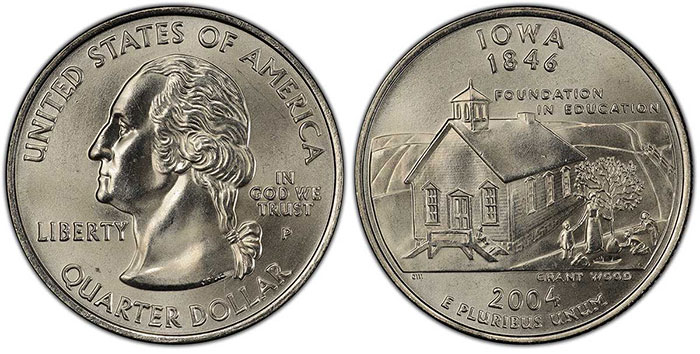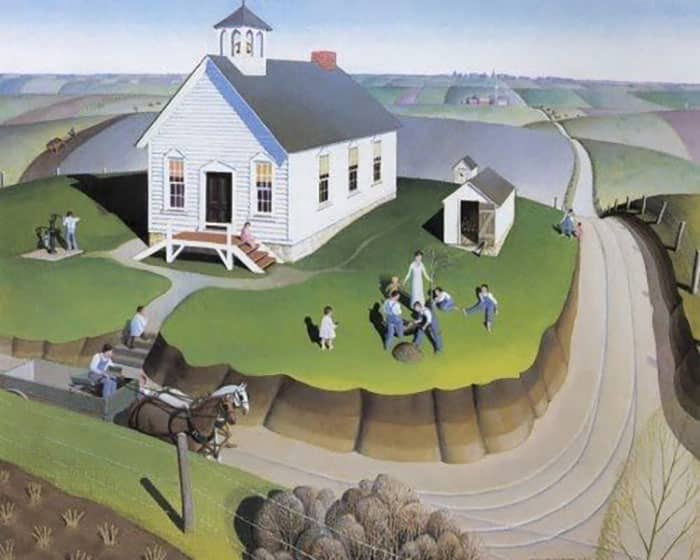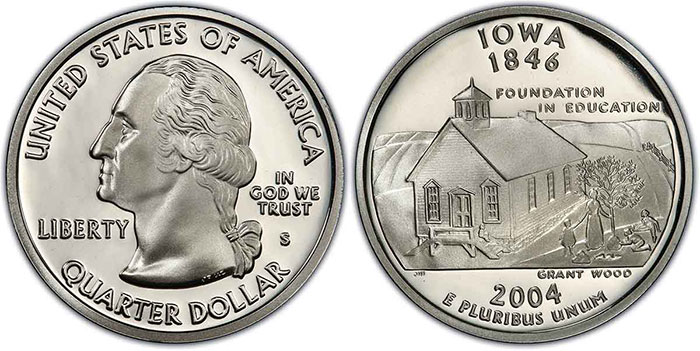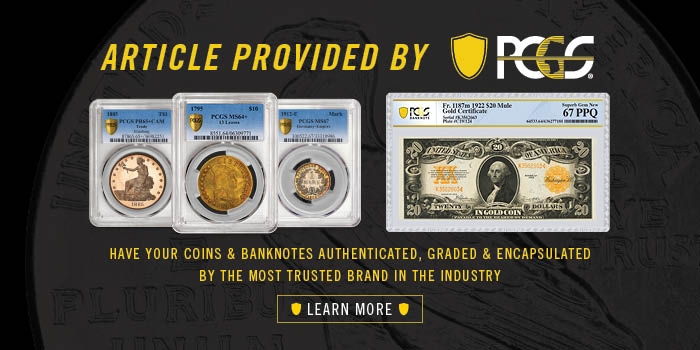
By Jay Turner for PCGS ……
Launched in 1999, the 50 State Quarters Program provided each state the reverse of the quarter as a canvas to feature a design emblematic of that state’s unique history, tradition, and symbolism. The 2004 Iowa quarter, the 29th state quarter to be issued in the series, has a design that features many facets of a rich history. The reverse was inspired by the works of Iowan artist Grant Wood and reflects the state’s history and pride for its future through education and a desire to leave a greener world for the next generation. So many people are tied into the backstory of Wood’s painting as replicated on the coin, itself designed by then-Chief Engraver of the United States Mint John Mercanti. It is a coin accessible to all and affordable to those on even the tightest numismatic budget.
How does a state come up with a design that commemorates itself? That was the task that all states had to deal with in choosing the design for their quarter. Iowa had no less of a difficult task with this assignment especially since Iowans don’t always agree on symbolism that represents them. Five proposals were sent to the United States Mint for review for the concept of the Iowa quarter. One theme that the Mint made several versions of was Iowa as an agriculture state — “FEEDING THE WORLD” as the motto of the coin and featuring corn, grain, pig, and cow.
Another concept was to feature the Sullivan brothers, five brothers who were killed in action in 1942 serving together on the USS Juneau during World War II.
The other three designs were all from paintings produced by Grant Wood, arguably one of the most famous Iowans and easily one of America’s most significant artists. The three Wood paintings featured on the other Iowa quarter concepts were Young Corn, American Gothic, and Arbor Day. Ultimately, it was the design based on Wood’s Arbor Day that was chosen by Iowa Governor Thomas Vilsack for use on the quarter.

Arbor Day, on which the design of the Iowa quarter is based, has an interesting story all to itself. Wood originally painted Arbor Day in 1932 as a gift and tribute to McKinley Junior High School, located in the district where Wood had taught art. The painting was a tribute to teachers Catherin Motejl and Rose L. Waterstradt, who had passed away. Wood and school principal Frances Prescott drove around eastern Iowa looking at one-room schoolhouses for inspiration. The problem was Wood brought a handle of whiskey for the ride and became more drunk than inspired. Eventually, Wood designed the schoolhouse in the painting himself, getting the most inspiration from his boyhood Antioch School house in Jones County. Cedar Rapids School District paid Wood $200 for Arbor Day and hung it on the wall. Wood requested the painting back and the school district returned it to him, with the artist instead exchanging it with a sketch called Tree Planting. Tree Planting served as the inspiration for Wood’s Tree Planting Group, which Wood would make and sell his first lithographs from.
Wood put Arbor Day on display in the Whitney Museum, where it was exhibited in Gallery V for the Second Biennial Exhibition of Contemporary American Painting exhibit from November 27, 1934, until January 10, 1935. After its display in the Whitney, Arbor Day was sold to King Vidor, the American film director and producer.
Vidor died in 1982, and his estate put the painting up for auction in 1985, where Sotheby’s sold it for $1,375,000 to become the first Wood painting to surpass the million-dollar mark. The buyer was William Koch, a billionaire businessman, who still owns the painting.
Arbor Day was chosen for the design of the Iowa quarter and was redesigned and modified by John Mercanti to fit the small canvas, with modifications accommodating the name of the state, date of statehood (1846), date of the coin’s issue, and “E PLURIBUS UNUM.” The legend “FOUNDATION IN EDUCATION” was added above the schoolhouse and the artist’s name Grant Wood was added below the design.
The design wouldn’t go without limited controversy. Arbor Day has the same name as a holiday first introduced in the United States in Nebraska, and the Nebraska quarter – the 37th issue for the series – wouldn’t be struck until 2006; the Nebraska quarter features Chimney Rock, a departure from the Arbor Day theme. Interestingly, some have pointed to the motto “FOUNDATION IN EDUCATION” on the Iowa quarter as a call to action to improve the educational standards for Iowan students.
The Iowa quarter is a common coin. The Philadelphia Mint’s output was 213,800,000 and the Denver Mint produced a mintage of 251,800,000. Many coins were saved from the 50 State Quarters program, and thus finding Uncirculated examples of both is very easy. The Philadelphia coins are typically in poorer condition than those from Denver, with the highest-graded example for a Philadelphia Mint Iowa quarter being just 21 examples in MS68, with one of these examples reaching a record price of $1,500 on eBay in 2019. In comparison, the Denver Mint Iowa quarter offers 571 examples graded MS68 by PCGS, a single example graded MS68+, and 10 specimens grading MS69. The record price for a Denver Iowa quarter was achieved in 2007 when a PCGS MS69 sold for $1,840 in a Heritage Auctions sale.

For Proof examples, the clad Proof San Francisco has a mintage of 2,740,684. PR70DCAMs are quite abundant, with 909 currently graded at PCGS and the typical sales price at under $30 on eBay for such a specimen. The silver San Francisco Mint proof issue has a mintage of 1,769,786, with PCGS grading 1,266 examples as PR70DCAM, with many selling for around $35.
* * *






Bullshit
Everyone tells me my coins r not worth anything
Coins are always worth “something”.
I have a bunch of those quarters. Big deal until someone wants them. It’s like my other collections. Who decides what has value and what does not?
On the back of any coins an in the words of America and The Letters A and M Are bonded together what is the Value Of that Coins
I am so interested and had a friend teach me a little about what to look for in coins. So we went threw all my change that I had saved for some time. My friend said I had lots if good coins worth pretty good money. He just never said how much money. So I sit here trying to learn from your tube as my coins are still sitting here in coins holders. I just don’t know enough to take them to get them looked at. And as many of my collection is too many to spend for grading. So not sure what to do. Anyways it still has my interest in coins collecting.
Rather than relying on YouTube which has everyone from experts to amateurs to scammers, it’s better to use solid, standard references like the Yeoman “Red Book” or sites run by major numismatic organizations like PCGS, ANA, etc.
YouTube can be an extremely valuable resource – I use it for advice on everything from tech to carpentry – but there’s essentially NO quality control. You need to already have some base-level knowledge so you can avoid bad info. For every good coin video I’ve seen, there are at least as many that are misleading, misinformed, or outright scams. E.g. look for all the posts pushing an “1851 Indian Head dollar” despite its being a well-known fake.
The mint has been minting too many proofs
I am in the same situation as Margaret
I have been saving my coins for about two years. Around or a little over $2000 worth
Trying to figure out what’s worth what. And what to do with them. It’s so over whelming I’m stuck and don’t know what to do. Still trying to learn as much as I can. But stuck just the same.
As I noted, start with sources like the Red Book and/or websites run by major numismatic associations. Steer clear of auction sites because it’s difficult to recognize what’s reliable unless you’re already knowledgeable.
Start by organizing your coins by denomination and date. Use the Red Book or a source like PCGS, ANA, etc. to learn where mint marks are located, then further organize your coins by mint marks within each date. Mint marks can be a bit daunting at first because not all US coins have them, and positions have changed over the years. That’s why I recommend having ready access to a good guidebook or info site.
The next step is to estimate condition. The Red Book or a source like Photograde should show examples of coins in each of the broad grading categories like Good, Very Good, Fine, and so on. Judging condition is an art as well as a science; the best any of us amateurs can do is make ballpark calls, but you have to start somewhere.
Once you have the four major factors – denomination, date, mint mark, and condition – in front of you there are plenty of “whatzit worth” sites that will give you ideas of retail prices. And again, it’s important to make sure the site has some sort of imprimatur from a respected numismatic source. [Yes, the Red Book lists them too but it’s only updated annually.] To keep track you could set up a simple spreadsheet or use one of the many organizer apps that are available.
My guess is that most of the coins will turn out to be fairly common dates, but without checking you’ll never know if there’s some hidden gem. If you do find something that stands out you can have it evaluated by a local dealer / appraiser. The difficult part for someone just starting out is to not be over-enthusiastic. You may find a lot of interesting coins but the likelihood of randomly getting one that pays the mortgage tends to be low. Use the experience to learn about the history surrounding the coins (e.g. finding a war nickel leads to learning more about WWII) rather than hoping to get rich. Happy collecting!
Very well written. I have many silver dollar coins from the seventies because well so am I lol. However I have a 1921 and. 1923 peace dollar as wel which has also misleading values and also half dollars two Dolla bills in sequence never circulated. And print sets from 1971 with a possibility of a double stamped penny. I been looking and looking but I guess my best thing is to take everything to get evaluated.. I appreciate your input on the Red book etc. Ty.
I am stuck also. I know I have valuable coins but just don’t know what to do